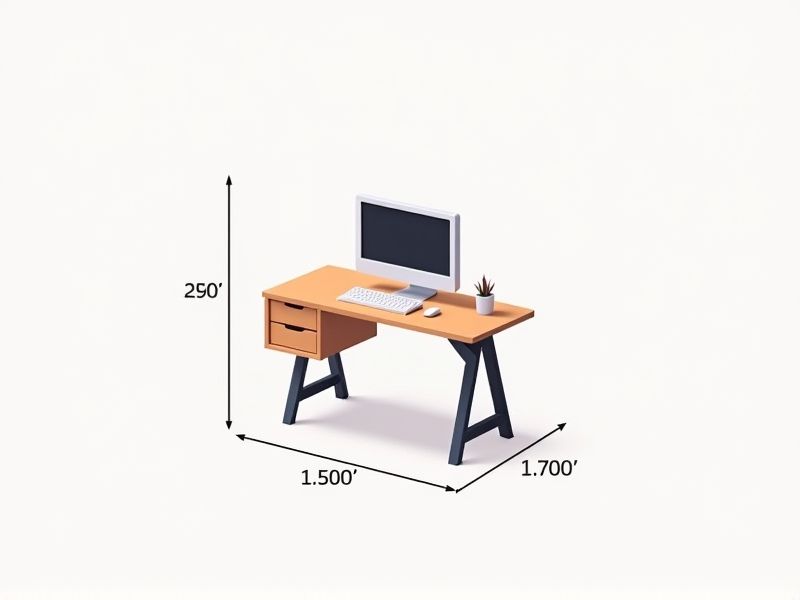
When choosing a computer desk, it's helpful to know the standard dimensions to ensure comfort and efficiency. Most computer desks are typically between 28 to 30 inches (71 to 76 cm) in height, which suits the ergonomic needs of most users. The standard width is usually around 48 inches (122 cm), providing enough workspace for a monitor, keyboard, and some additional items. Depths commonly range from 24 to 30 inches (61 to 76 cm), allowing enough room for equipment and comfortable leg space.
Height: 28-30 Inches
The standard height for a computer desk typically ranges from 28 to 30 inches, providing an ergonomic workspace suitable for various users. This ergonomic range accommodates individuals of different heights, promoting comfort and reducing strain during long working hours. When choosing a desk, ensure it allows for your elbows to rest at a 90-degree angle while typing, which enhances your overall productivity. Consider investing in adjustable options if multiple users will utilize the workstation, ensuring everyone enjoys optimal ergonomics.
Width: 48-72 Inches
The standard width of a computer desk typically ranges from 48 to 72 inches, providing ample space for various devices and work materials. A desk width of 48 inches is suitable for smaller home offices or limited spaces, offering enough room for a monitor and keyboard. In contrast, a 72-inch desk is ideal for multitaskers, accommodating multiple monitors, printers, and documents with ease. When choosing your desk, consider how the width complements your workspace and personal workflow needs.
Depth: 24-36 Inches
The standard depth for a computer desk ranges from 24 to 36 inches, providing ample space for various equipment and personal items. This depth ensures that you have enough room for a monitor, keyboard, and mouse without compromising comfort or accessibility. A deeper desk may enhance your workspace by allowing for additional storage options, such as drawers or shelves. When selecting your desk, consider how the depth complements your overall setup and ergonomics to optimize your productivity.
Legroom Clearance: 20-24 Inches
A computer desk with optimal legroom clearance of 20-24 inches significantly enhances your comfort and productivity during extended work sessions. This height range accommodates various user preferences and body types, ensuring that you can sit or stand comfortably. Proper legroom is essential for maintaining good posture and reducing fatigue, allowing for improved focus. Investing in a desk within this clearance range can lead to a more ergonomic workspace, promoting better health and efficiency.
Material: Wood Or Composite
A standard computer desk typically features materials such as solid wood or high-quality composite wood, both offering durability and aesthetic appeal. Solid wood options, like oak or maple, provide a sturdy and timeless look, often with a natural finish highlighting the grain pattern, which can enhance your home office style. Composite wood, including MDF or particleboard, delivers an economical alternative while maintaining resilience and ease of assembly. When choosing between wood and composite, consider the weight capacity and longevity, as solid wood generally surpasses composite in these areas, ensuring long-term use.
Cable Management Provisions
A quality computer desk typically integrates comprehensive cable management solutions to enhance organization and aesthetic appeal. Features may include built-in cable trays, grommets, and clips, allowing you to route and conceal wires efficiently. A desk with effective cable management not only minimizes clutter but also contributes to a safer workspace by reducing trip hazards associated with loose cables. Investing in a desk with these provisions can significantly improve your productivity and maintain a clean, professional environment.
Adjustable Keyboard Tray
An adjustable keyboard tray enhances ergonomics by allowing a comfortable typing position, reducing strain on your wrists and arms. Most ergonomic desks come with trays that can be adjusted to various heights, often ranging from 3 to 6 inches below the desktop, accommodating different user preferences and body types. This feature not only promotes better posture but also helps in maximizing workspace efficiency by freeing up desk surface area. Choosing a computer desk with an adjustable keyboard tray can significantly improve your productivity and comfort during extended periods of use.
Weight Capacity: 100-150 Pounds
A standard computer desk typically has a weight capacity ranging from 100 to 150 pounds, making it suitable for various setups. This capacity ensures stability and durability, accommodating multiple devices such as monitors, printers, and your workspace essentials without compromising safety. When choosing a desk, consider the weight of your equipment combined with any additional items like books or decor to ensure an optimal fit. Selecting a desk that falls within this weight capacity range will enhance your overall productivity and comfort while working.
Ergonomic Design Features
An ergonomic computer desk is designed to enhance comfort and productivity by promoting good posture, with adjustable heights typically ranging from 28 to 48 inches. Features like a spacious work surface of at least 60 inches and built-in cable management help reduce clutter, ensuring a tidy workspace. Studies indicate that using an ergonomic desk can decrease the risk of musculoskeletal disorders by up to 50%. When considering your next desk purchase, prioritize models with ample legroom, adjustable monitors, and materials that offer durability and support.
Surface Finish: Laminate Or Veneer
When selecting a computer desk, the surface finish plays a crucial role in durability and aesthetics, with laminate and veneer being the two primary options. Laminate offers a non-porous, easy-to-clean surface that is resistant to scratches and stains, making it ideal for high-traffic areas. In contrast, veneer, typically made from thin layers of real wood, provides a more elegant appearance and better tactile sensations but may require more maintenance and care. Your choice between laminate and veneer ultimately depends on your priorities for durability versus aesthetic appeal.
